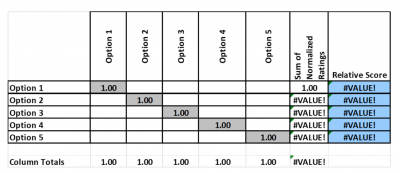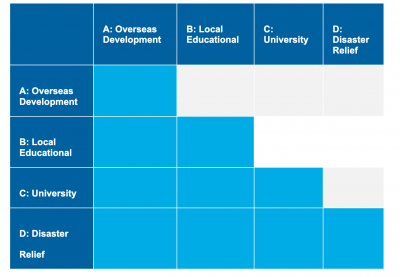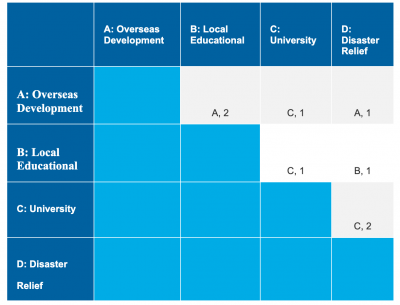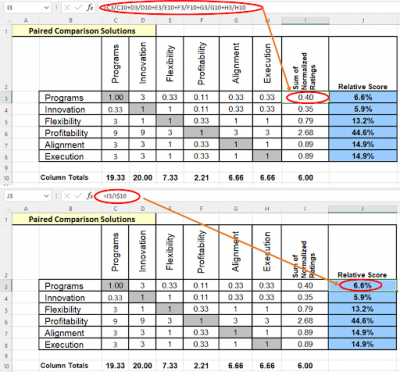
Key Points
- AHP is a means of making decisions through the use of data.
- It provides a framework for making decisions as a group.
- Using AHP means you’re making decisions now, rather than waffling over it.
When making decisions about which car to purchase, which house to buy, where to take your family vacation, or where to go to dinner, you often have to evaluate and prioritize multiple criteria and choices. The same goes for which customer requirement you need to focus on when doing your Six Sigma project. Let’s learn how AHP might be a good tool for prioritizing your decisions.
Overview: What Is the Analytic Hierarchy Process (AHP)?
AHP is a structured group decision-making technique for organizing and analyzing complex decisions. It was developed by Thomas L. Saaty in the 1970s. It represents a semi-objective approach to quantifying the weights and preferences of decision criteria. Using a specially designed format, each member of the team uses the process of a forced choice paired comparison to rate the relative importance of each pair of items.
Once the appropriate criteria or elements of the decision have been selected, the group members systematically evaluate the various elements by comparing them to each other two at a time. In making the paired comparisons, the group can use actual data about the elements, but they typically use their subjective judgments about the elements’ relative importance.
The AHP assigns numerical values to these evaluations. In the final step of the process, numerical priorities are calculated for each of the decision criteria. Based on these, the group can now make an informed decision as to the relative importance of the decision elements.
While there is some flexibility in format and procedure, here is a common one used by numerous organizations. The calculations can easily be done by doing this in an Excel worksheet.
1) Start with a table listing the evaluation criteria on each axis.
2) Working row by row, ask whether the row element is more important than the column element and if so, how much more important.
3) Using a scale of 1-9, with the following definitions, works well.
(1) Equally important
(3) Moderately more important
(5) Strongly more important
(7) Very strongly more important
(9) Overwhelmingly more important
4) Enter the number value if the row is more important than the column.
5) If the column is more important than the row, use the inverse of the number value.
6) Note where the row and column elements are the same, the value will be 1.

The calculations will be explained in the example presented later.
Why It Works
When we approach any sort of problem or issue in Six Sigma, data is key. Having actionable, readable data is one of the most powerful tools at your disposal. As such, it only stands to reason that having the means, data, and team input can make it so you’re making the decisions that benefit your organization.
3 Benefits of AHP
AHP combines group decision-making with a quantitative evaluation to provide a more structured approach than just flipping a coin or using purely a subjective approach
1. Forces a Choice
When asked to decide between multiple choices, people often say they are all equally important. By forcing a choice between paired comparisons you will eventually end up with a prioritized listing of the choices.
2. Group Decision Making
Although a bit trickier than a single individual making the decision, the use of a group will provide a broader and more complete perspective.
3. Calculations Are Simple
The actual calculations for prioritization are simple, especially if you set up the matrix in an Excel worksheet.
Why Is AHP Important to Understand?
A structured way of choosing among alternatives is better than just guessing. Understanding how AHP works is important to make use of this powerful but simple technique.
Does Not Provide the Correct Decision
The value of AHP is that it consolidates the understanding and perspectives of a group of people. This makes the eventual decision optimal for that group, not necessarily the best or most correct one.
Is Useful When Hard Quantitative Data May Not Be Available
If you have hard quantitative data you can choose amongst alternatives using such tools as hypothesis testing, regression, or Design of Experiments. When this kind of data is not readily available, AHP is an optional approach.
Other Formats and Procedures Can Be Used
Below is an example (AHP Example) of another approach than the one described above.
A philanthropist is choosing between several different non-profit organizations that are asking for funding. To maximize impact, she only wants to contribute to a few of these, and she has the following options:
- An overseas development project
- A local educational project
- A bequest for her university
- Disaster relief
First, she draws up the Paired Comparison Analysis table in Figure 1.
Figure 1 – Example Paired Comparison Analysis Table (not filled in):

Then she compares options, writes down the letter of the most important option, and scores their difference in importance to her. Figure 2 illustrates this step of the process.
Figure 2 – Example Paired Comparison Analysis Table (filled in):

Finally, she adds up the A, B, C, and D values and converts each into a percentage of the total. These calculations yield the following totals:
- A = 3 (37.5 percent)
- B = 1 (12.5 percent)
- C = 4 (50 percent)
- D = 0
Here, she decides to make a bequest to her university (C) and to allocate some funding to overseas development (A).
An Industry Example of AHP
The Master Black Belt (MBB) of a large consumer products company was charged with the responsibility of determining the marketing priorities for creating customer promotional programs. After gathering some customer feedback, the marketing senior leadership determined the priorities should be maximizing the number of programs and making sure they were innovative and creative.
The MBB suggested they confirm this by having a focus group of customers complete an AHP analysis. Below is what the customers came up with. Note how the values are computed. The scale they used was 1, 3, 9.

The interesting thing is that the marketing leadership wanted to focus on Programs and Innovation which were the two lowest priorities of the customers. Instead, the customers were concerned with the Profitability of the programs, Alignment to their internal programs, and Execution of the programs. The simple use of AHP prevented the company from spending time and resources on actions that had low priority with the customer.
3 Best Practices When Thinking About AHP
While AHP is a relatively simple technique, there are a few things to consider to make it work better.
1. Select a Reasonable Scaling
While the discussion above suggested a 1, 3, 5, 7, and 9 scale, you can also use a 1-5, 1-10, or a simple 1, 3, 9 scale as well.
2. Don’t Select Too Many Criteria or Options to Evaluate
Too many options, especially if they are similar, are not recommended. There needs to be sufficient difference between the options otherwise the group may have difficulty differentiating between them.
3. Select a Process by Which You Can Consolidate the Group Evaluations
People will have different perspectives as to the relative importance of the criteria as well as the magnitude of preference. Have the team decide how to consolidate all the differing opinions and reach a consensus.
RELATED: PUGH MATRIX VS. ANALYTICAL HIERARCHY PROCESS
Other Useful Tools and Concepts
Looking for some other ways to help your organization? You might do well to take a look at the likes of the Bartlett Test. This is a great way of conducting statistical analysis, at least when looking for deviations from normal distributions.
Additionally, you might need to know the differences between subject matter experts and consultants. These roles are vital in any organization, but the individuals behind them could not be more different. As such, knowing the differences can only help your organization in the long run.
Using AHP to Prioritize Your Decision Criteria
AHP is a group activity to evaluate, rate, rank and prioritize options whether they be in your personal life or at work. Using the process of forced choice paired comparisons, the group looks at all pairs of the criteria and collectively decides which option is preferred and by how much. From there, it is just a matter of computing weighted preferences and then ranking them in numerical order.